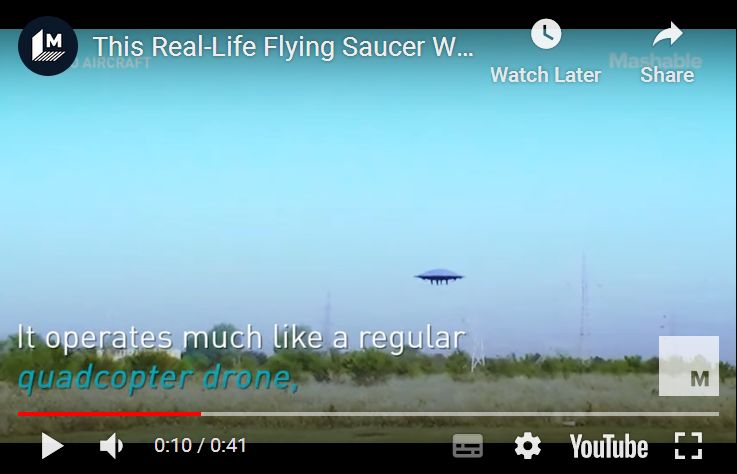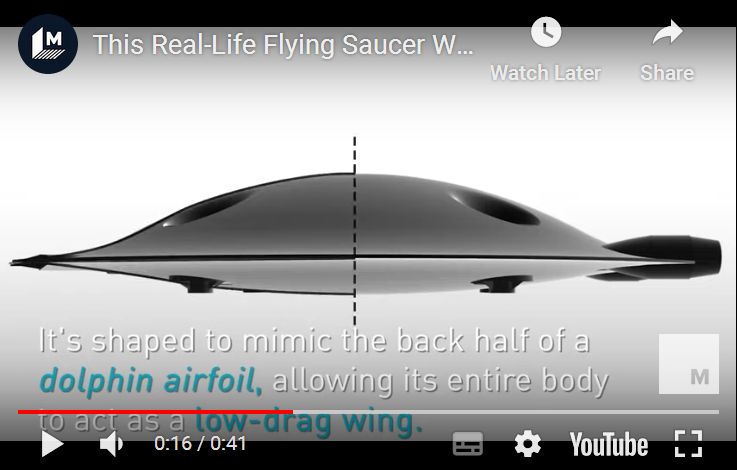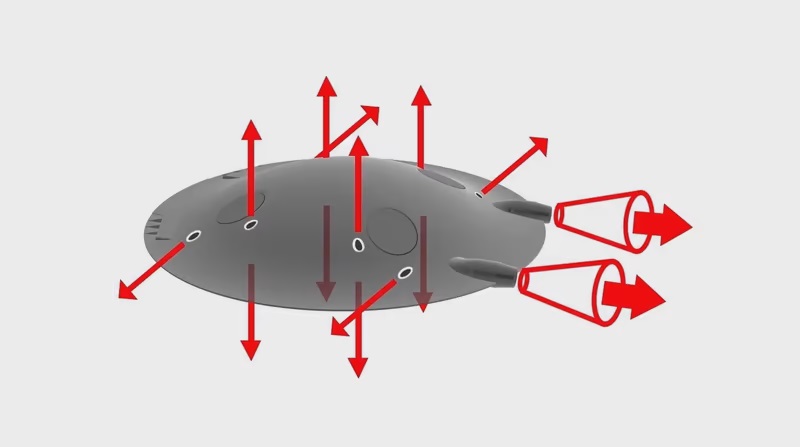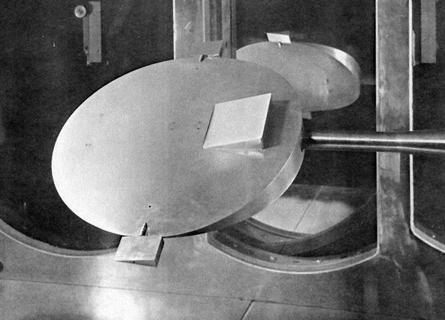It looks like you're using an Ad Blocker.
Please white-list or disable AboveTopSecret.com in your ad-blocking tool.
Thank you.
Some features of ATS will be disabled while you continue to use an ad-blocker.
share:
Hello everyone, Some of You may Remember a Thread I did a Little while back called '' A
Round Flat Circular Wing '' ,In This Thread I bring up That I Sometimes design Aircraft that Resemble what is Commonly called a UFO and Bring Up
the Idea of a flat round winged aircraft, Well Apparently im not the only one. They Call it ADIFO ( All Direction Flying Object ), Currently It is a 4
Foot flying Disk Shaped Drone Prototype, The Prototype Currently acts Like a Quadcopter Drone in Flight, But there is a place for Some type of jet
technology.
The Aircraft is Shaped to Mimic the Back half of a Dolphin Airfoil, Allowing its Entire Body to act as a Low Drag Wing. They go On to say That With the Right Jet Technology there would be no Sonic Boom when going Supersonic,The Company is Company is Looking for Investors, i hope They get it.
What are Your Thoughts or Opinions?
The Aircraft is Shaped to Mimic the Back half of a Dolphin Airfoil, Allowing its Entire Body to act as a Low Drag Wing. They go On to say That With the Right Jet Technology there would be no Sonic Boom when going Supersonic,The Company is Company is Looking for Investors, i hope They get it.
What are Your Thoughts or Opinions?
edit on 27-6-2023 by theboarman because: (no reason given)
edit on 27-6-2023 by theboarman
because: (no reason given)
edit on 27-6-2023 by theboarman because: (no reason given)
edit on 27-6-2023 by theboarman
because: (no reason given)
edit on 27-6-2023 by theboarman because: (no reason given)
edit on 27-6-2023 by theboarman
because: (no reason given)
watching now. Thanks for sharing
edit on 27-6-2023 by TXRabbit because: (no reason given)
a reply to: theboarman
So cool, thanks for the share!
Watching makes think how it could develope in the future.
Add some stabilizers and some jet power and can here the jetsons theme song
Makes me think of something i saw a awhile back. its a small unit that uses a sort of jet thruster, in short bursts to maintain and change its position, i think they were testing it for use in space...
Im gonna have to search for that so you can see
Edit: i found it!!!!! this video still gives me goosebumps for some reason
So cool, thanks for the share!
Watching makes think how it could develope in the future.
Add some stabilizers and some jet power and can here the jetsons theme song
Makes me think of something i saw a awhile back. its a small unit that uses a sort of jet thruster, in short bursts to maintain and change its position, i think they were testing it for use in space...
Im gonna have to search for that so you can see
Edit: i found it!!!!! this video still gives me goosebumps for some reason
edit on 27pm301000000023 by datguy because: (no reason given)
it sure does look like it's time
to see a flood of new UFO videos coming out soon
to see a flood of new UFO videos coming out soon
There are people from the government who have just testified under oath to congress that they have first-hand seen UFOs and aliens in the government's
possession. Marco Rubio explained this in an interview today.
My opinion is that Elon Musk should pull his head out of his ass and get access to some of this technology to help him with his private space program. I say this because he can do it... but only if he stops being an idiot. He is one of the UFO skeptics at the moment.
The technology definitely exists to make spacecraft a thousand times better than the ones Elon makes yet for some reason it is not used?
One theory I heard is that the government does not want aliens to know how far we have come with our black technology. They want it to be a surprise in case of a war.
My opinion is that Elon Musk should pull his head out of his ass and get access to some of this technology to help him with his private space program. I say this because he can do it... but only if he stops being an idiot. He is one of the UFO skeptics at the moment.
The technology definitely exists to make spacecraft a thousand times better than the ones Elon makes yet for some reason it is not used?
One theory I heard is that the government does not want aliens to know how far we have come with our black technology. They want it to be a surprise in case of a war.
edit on 28amWed, 28 Jun 2023 01:13:58 -0500kbamkAmerica/Chicago by darkbake because: (no reason given)
Can a pilot in a full scale craft endure the G forces like that model displayed.
Kind regards,
Bally
Kind regards,
Bally
Naah, have you ever seen the concept car from the 1960s that were supposed to be the cars of the future. This isn't new, please look up the VZ-9
Avrocar. Yes it only has 1 rotor and this has 4. but what both don't show with the videos in the actual noise these thing make. yeah you can have a
quiet one with small electric motors but they aint practical in the real war time scenario.
datguys video, same thing, looks great as a toy but multiply it up to bigger size and you wouldn't have enough room for fuel at the rate it uses it. That's why it died.
datguys video, same thing, looks great as a toy but multiply it up to bigger size and you wouldn't have enough room for fuel at the rate it uses it. That's why it died.
a reply to: theboarman
One UAV doesn't a future make. It simply means that one company sees this as a way forward.
One UAV doesn't a future make. It simply means that one company sees this as a way forward.
a reply to: bally001
It's a common misconception that high speed puts extreme Gs on the pilot. The pilot is accelerating with the aircraft, so there are minimal G forces on them. It's like when you're taking off on a commercial flight. There's a slight push backwards from the acceleration, but that's it. Higher speed doesn't equal higher Gs during acceleration. The acceleration to get to higher speed is pretty consistent.
It's a common misconception that high speed puts extreme Gs on the pilot. The pilot is accelerating with the aircraft, so there are minimal G forces on them. It's like when you're taking off on a commercial flight. There's a slight push backwards from the acceleration, but that's it. Higher speed doesn't equal higher Gs during acceleration. The acceleration to get to higher speed is pretty consistent.
edit on 6/28/2023 by Zaphod58
because: (no reason given)
a reply to: theboarman
It's interesting, but I don't see it being scaled up very well, or fitting anything but a niche market.
It's interesting, but I don't see it being scaled up very well, or fitting anything but a niche market.
originally posted by: datguy
a reply to: theboarman
So cool, thanks for the share!
Watching makes think how it could develope in the future.
Add some stabilizers and some jet power and can here the jetsons theme song
Makes me think of something i saw a awhile back. its a small unit that uses a sort of jet thruster, in short bursts to maintain and change its position, i think they were testing it for use in space...
Im gonna have to search for that so you can see
Edit: i found it!!!!! this video still gives me goosebumps for some reason
Wow! It’s a “Death Blossom.”
The video says it acts like a quadcopter, EXCEPT it can fly in any direction, implying a quadcopter can't do that. What? That makes no sense. Quadcopters CAN fly in any direction, can't they?
originally posted by: theboarman
The Prototype Currently acts Like a Quadcopter Drone in Flight, But there is a place for Some type of jet technology.


Then in an apparent contradiction of that claim, it shows two (apparently model or fake) jet engines which definitely make it more unidirectional tham omnidirectional:

If they were real engines, they would be heavy and form a weight imbalance.
Speaking of weight, that's very important in aircraft. So it's sort of like a quadcopter but the propellers are inside the aerodynamic shell, so compared to a quadcopter it apparently has a weight disadvantage because that shell weighs something. So you would actually have to run tests to see if the reduction in aerodynamic drag from the shell gives it more airtime than a similar quadcopter without the shell.
Also, I remember an aeronautical engineer wrote a long reply to your proposed disc aircraft design citing a lot of reasons why the design wasn't optimal. Wouldn't those apply here too?
www.abovetopsecret.com...
For subsonic aircraft, designers generally prefer a rounded leading edge for the airfoil because it allows a greater range for AoA (angle of Attack) without problems. A sharp leading edge for subsonic craft (it's demonstrated in subsonic mode and I doubt that model can go supersonic) can cause problems as described here:
aviation.stackexchange.com...
To increase the range of angles of attack at wich the boundary layer stays attached and to allow for a more gradual transition between normal flow and stall, the designers favour a quite blunt leading edge for most commercial and general aviation aircraft. This will increase the drag at zero AoA, but won't force the air to follow a high curvature at positive AoAs.
If it actually flew supersonic, first of all forget the omnidirectional claim when it's supersonic, and in that case the sharp leading edge would make more sense. But the omnidirection shape is not inherently stable, I think you need some drag in the rear end of the aircraft in things like tail fins, or at least swept wings, for natural aerodynamic stability. I remember seeing someone testing various designs in a wind tunel and if there wasn't enough drag in the rear end of the aircraft, it was unstable. I think that's why most planes seem to have tail fins and a vertical stabilizer. An exception is the B-2 which doesn't have either, but it uses computer control of the trailing surfaces of the wings. So that can be done but then it's no longer omnidirectional, it would need the control surfaces in the rear of the airfoil like the B-2 has, if you wanted to use the principles of how the B-2 flies in a flying wing type of design.
Another advantage of the B-2 flying wing is the aspect ratio, it's not round, so the drag from the wingtip vortices is not as big a problem as it would be with a circular flying wing, which is going to create a lot of drag from the vortices. The circular wing Flapjack used counter-rotating propellers to help combat that problem, but the design proposed in the OP lacks such propellers:
During WWII, Charles H. Zimmerman led a team at Chance-Vought that created a series of designs that eventually resulted in the Vought Flying Flapjack,[5] one of the first aircraft explicitly designed as a disc for aerodynamic reasons. The Flapjack had a large wing and very low wing loading, allowing it to take off easily from aircraft carriers. As with the earlier Vought V-173, the Flapjack's counter-rotating propellers were located at the ends of the wings to help counteract the drag-inducing vortices that would normally result from a wing of such a low aspect ratio. By the time the design was flying in the post-war era, jet engines had rendered the design obsolete and the US Navy lost interest.
My main thought is it seems a bit uncertain about what it is, is it omnidirectional as claimed or does it fly in a particular direction because of the jet engines? Is it subsonic or supersonic? Obviously the test flight is subsonic but they are hyping supersonic, but I'd love to see what happens to that design in supersonic wind tunnel tests. My prediction is it would be a disaster, but I'd love to see a test that proves otherwise.
a reply to: SonofaSkunk
Hello, Thank You For Keeping My Thread Alive, You have to Remember That This is only a Prototype, There Would be Many Changes to The finale Product Both Internal And External, Even more So if It were to Carry Humans, Aircraft go Through Re-Designs all the time.This Website Page Has more Information and Pictures,Pictures like This one Where it Shows How it will Manoeuvre or Seem to Out-Manoeuvre Anything Today.

As You can See there Will be many little Jets, Similar to The "Harrier Jump Jet'' , But These will be for Manoeuvring Instead of Vertical Take Off, Giving it Unparalleled Manoeuvrability
To your Point that Some Random Person On My Other Thread Stated That This Was Impossible Because Designers At an Earlier time Couldn't Figure It out Is Laughable, You Are On ATS so You know Great Ideas Are Thought of As Crazy And Implausible Before they Catch on.
You say You seen My Thread Called A Round Flat Circular Wing , Did you see the Responce of ''Oldcarpy2'' ,He Brings Up The Convair Pye Wacket This Link , I Highly Recommend Following the link To Learn More but here is A photo of what it looked like To show that a saucer shape is possible.

And are You Missing the Point that It's Whole body is a Wing? I just feel You Are trying to Debunk The Idea of the craft because ''Aliens''
Hello, Thank You For Keeping My Thread Alive, You have to Remember That This is only a Prototype, There Would be Many Changes to The finale Product Both Internal And External, Even more So if It were to Carry Humans, Aircraft go Through Re-Designs all the time.This Website Page Has more Information and Pictures,Pictures like This one Where it Shows How it will Manoeuvre or Seem to Out-Manoeuvre Anything Today.

As You can See there Will be many little Jets, Similar to The "Harrier Jump Jet'' , But These will be for Manoeuvring Instead of Vertical Take Off, Giving it Unparalleled Manoeuvrability
To your Point that Some Random Person On My Other Thread Stated That This Was Impossible Because Designers At an Earlier time Couldn't Figure It out Is Laughable, You Are On ATS so You know Great Ideas Are Thought of As Crazy And Implausible Before they Catch on.
You say You seen My Thread Called A Round Flat Circular Wing , Did you see the Responce of ''Oldcarpy2'' ,He Brings Up The Convair Pye Wacket This Link , I Highly Recommend Following the link To Learn More but here is A photo of what it looked like To show that a saucer shape is possible.

And are You Missing the Point that It's Whole body is a Wing? I just feel You Are trying to Debunk The Idea of the craft because ''Aliens''
edit on 16-7-2023 by theboarman because: spelling
new topics
-
Putin will warn civilians in targeted areas
World War Three: 22 minutes ago -
The Popular Vote does not matter
US Political Madness: 1 hours ago -
Gaetz withdraws from attorney general consideration
US Political Madness: 4 hours ago -
Bridgewater Triangle
General Chit Chat: 4 hours ago -
Is Russia Using a New Type of Beam Weapon Against Ukraine?
Weaponry: 6 hours ago -
Here is why Western leaders in NATO have zero fear of nuclear warfare. At all. Zero.
World War Three: 7 hours ago -
International Criminal Court Issues Arrest Warrant For Netanyahu
Breaking Alternative News: 8 hours ago -
racist rant, but she made the arguement to get rid of DEI
US Political Madness: 9 hours ago -
Well we know Putins ICBMs won't fail in their silos
World War Three: 10 hours ago
top topics
-
Well we know Putins ICBMs won't fail in their silos
World War Three: 10 hours ago, 12 flags -
racist rant, but she made the arguement to get rid of DEI
US Political Madness: 9 hours ago, 9 flags -
Is Russia Using a New Type of Beam Weapon Against Ukraine?
Weaponry: 6 hours ago, 8 flags -
International Criminal Court Issues Arrest Warrant For Netanyahu
Breaking Alternative News: 8 hours ago, 8 flags -
Gaetz withdraws from attorney general consideration
US Political Madness: 4 hours ago, 7 flags -
Bridgewater Triangle
General Chit Chat: 4 hours ago, 5 flags -
Why isn't Psychiatry involved?
Social Issues and Civil Unrest: 16 hours ago, 4 flags -
Here is why Western leaders in NATO have zero fear of nuclear warfare. At all. Zero.
World War Three: 7 hours ago, 4 flags -
The Popular Vote does not matter
US Political Madness: 1 hours ago, 3 flags -
Putin will warn civilians in targeted areas
World War Three: 22 minutes ago, 0 flags
active topics
-
Putin will warn civilians in targeted areas
World War Three • 1 • : Flyingclaydisk -
Post A Funny (T&C Friendly) Pic Part IV: The LOL awakens!
General Chit Chat • 7808 • : bluemooone44 -
Is Russia Using a New Type of Beam Weapon Against Ukraine?
Weaponry • 14 • : Zaphod58 -
Gaetz withdraws from attorney general consideration
US Political Madness • 14 • : CriticalStinker -
The Popular Vote does not matter
US Political Madness • 6 • : AdultMaleHumanUK -
Well we know Putins ICBMs won't fail in their silos
World War Three • 115 • : KrustyKrab -
Gaetz ethics investigation results "hacked".
US Political Madness • 37 • : Owlwatcher -
International Criminal Court Issues Arrest Warrant For Netanyahu
Breaking Alternative News • 35 • : JJproductions -
Help in song interpretation
Music • 10 • : tarantulabite1 -
Russia Ukraine Update Thread - part 3
World War Three • 6861 • : Oldcarpy2
